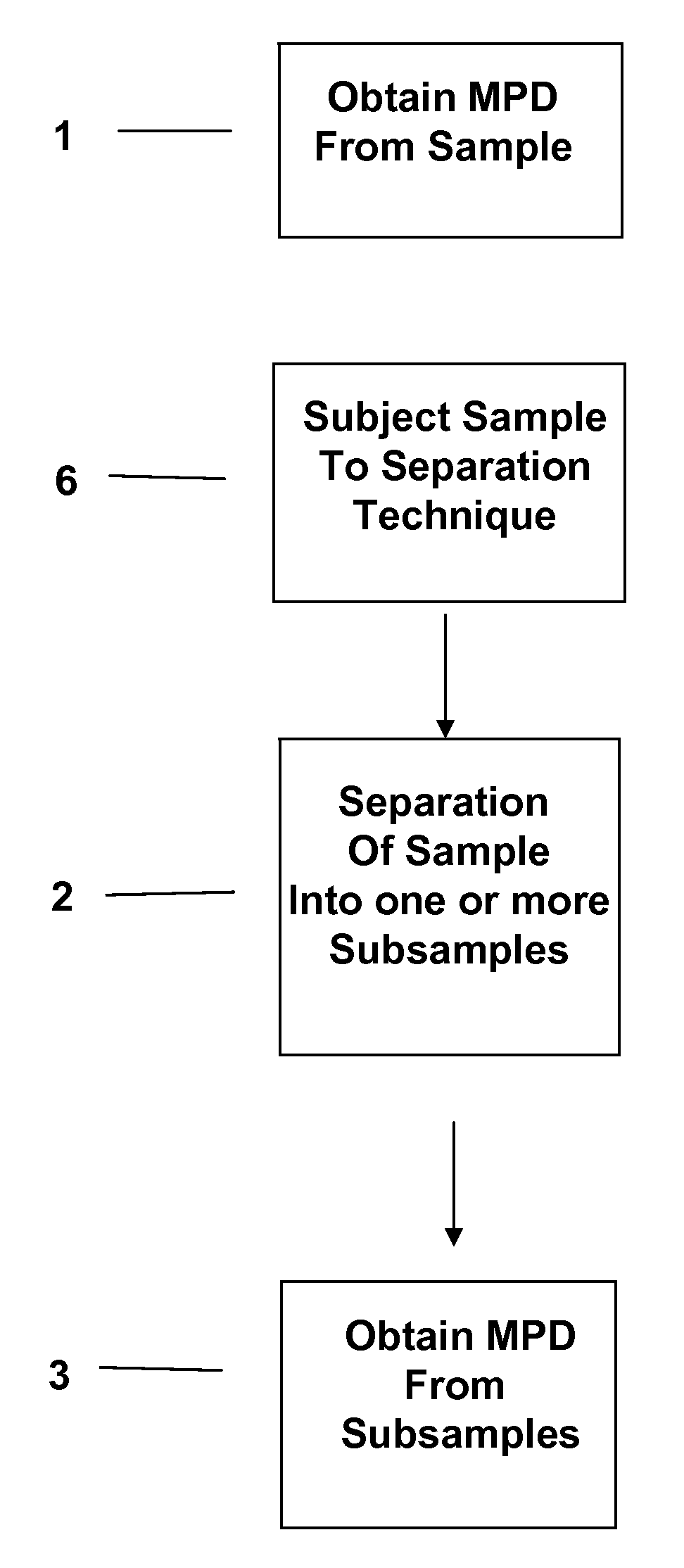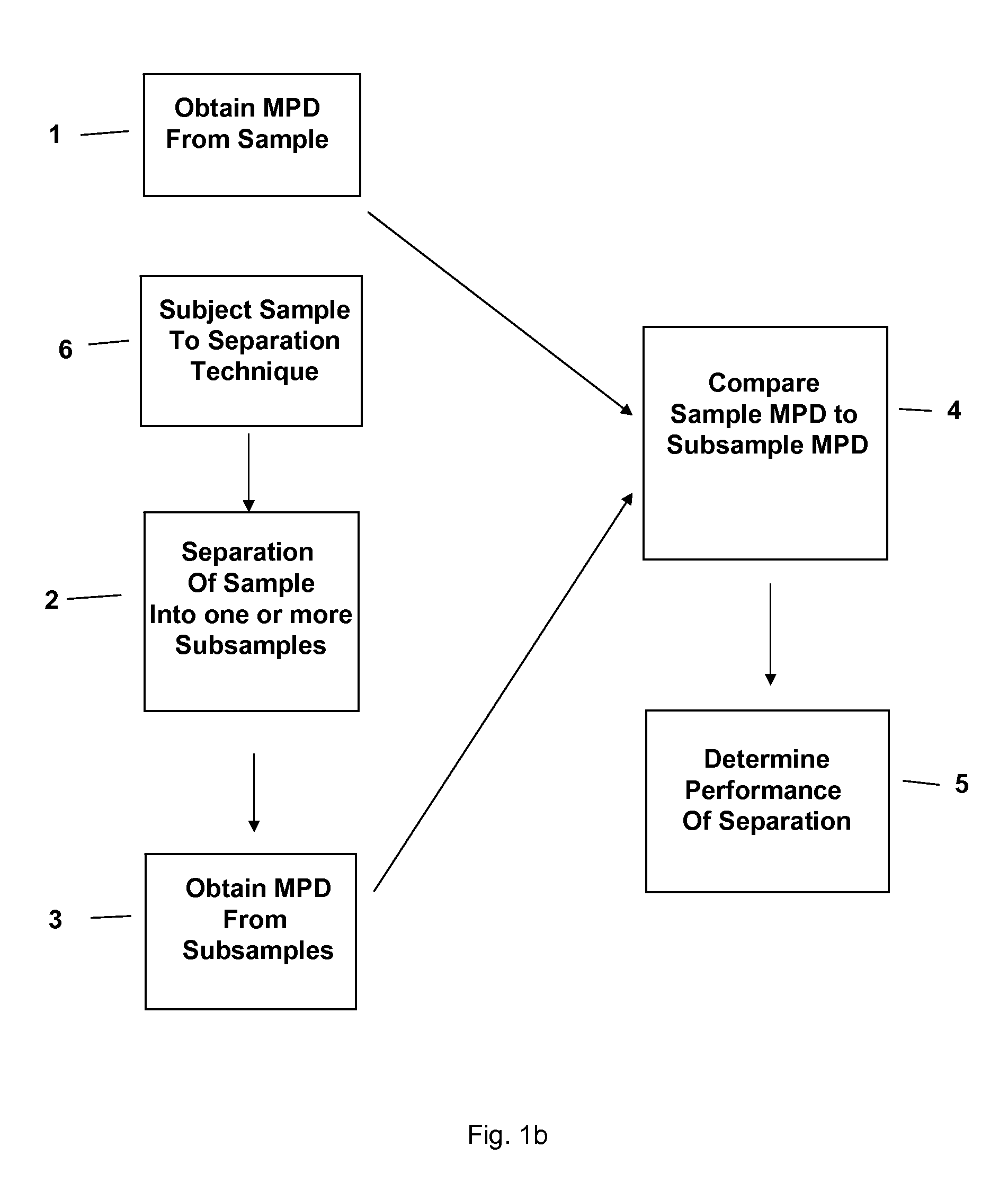Separation technology method and identification of error
a separation technology and error detection technology, applied in the field of separation technology methods and errors, can solve the problems of insufficiently addressed limitations and problems in separation technology, components in overlapped peaks often cannot be distinguished, and limitations of separation technology
- Summary
- Abstract
- Description
- Claims
- Application Information
AI Technical Summary
Benefits of technology
Problems solved by technology
Method used
Image
Examples
example 1
HPLC-UV / Vis of Samples
[0166]A HPLC instrument with UV / Vis diode-array detection uses the following method to analyze samples: obtain a UV / Vis spectrum from the sample prior to chromatographic separation, subject the sample to a chromatographic separation, obtain a series of on-line continuous-flow UV / Vis spectra from the subsamples after the chromatographic separation, compare the combined UV / Vis spectra from the subsamples measured after chromatographic separation to the UV / Vis spectrum of the sample obtained before chromatographic separation. In this particular example, the HPLC instrument collects both the pre-separation and post-separation UV / Vis spectra from one flow cell by switching flow paths (see FIG. 3). In this particular example, the HPLC instrument uses a liquid-core waveguide as the flow cell for UV / Vis measurements to minimize effects of index of refraction on optical pathlength. In this particular example, the flow cell temperature is set to 25 C during the analysis....
example 2
HPLC-UV / Vis-MS of Samples
[0175]A HPLC instrument with UV / Vis diode-array detection and MS detection uses the following method to analyze samples: inject a first aliquot volume of the sample for analysis, obtain an on-line continuous-flow UV / Vis spectrum from the sample prior to any type of separation, conduct a scout separation on a short chromatographic column, obtain a series of on-line continuous-flow MS spectra from the sample (which has potentially been separated) after being subjected to the scout separation, inject a second aliquot volume of the sample for analysis, subject the sample to a comprehensive chromatographic separation, obtain a series of on-line continuous-flow UV / Vis spectra and MS spectra from the subsamples after the comprehensive separation, compare the composite UV / Vis spectra from the subsamples measured after chromatographic separation to the UV / Vis spectrum of the sample obtained before any type of chromatographic separation, compare the list of the peaks ...
example 3
HPLC-UV / Vis of Manufactured Active Pharmaceutical Ingredient to Check Purity
[0191]A HPLC instrument with UV / Vis diode-array detection uses the following method to analyze sample [manufactured Active Pharmaceutical Ingredient (API)] as a quality check to determine purity: obtain a UV / Vis spectrum from the sample prior to chromatographic separation, subject the sample to a chromatographic separation, obtain a series of on-line continuous-flow UV / Vis spectra from the subsamples after the chromatographic separation, subtract the UV / Vis spectra of the subsamples measured after chromatographic separation from the UV / Vis spectrum of the sample obtained before chromatographic separation.
[0192]In this particular example, the API has an unknown impurity present. Following the analysis method, the device first collects a UV / Vis spectrum of the sample prior to separation. Comparing the collected UV / Vis spectrum of the sample to the electronic library UV / Vis reference spectrum, a difference is n...
PUM
| Property | Measurement | Unit |
|---|---|---|
| Time | aaaaa | aaaaa |
| Stability | aaaaa | aaaaa |
| Spectrum | aaaaa | aaaaa |
Abstract
Description
Claims
Application Information
 Login to View More
Login to View More - R&D
- Intellectual Property
- Life Sciences
- Materials
- Tech Scout
- Unparalleled Data Quality
- Higher Quality Content
- 60% Fewer Hallucinations
Browse by: Latest US Patents, China's latest patents, Technical Efficacy Thesaurus, Application Domain, Technology Topic, Popular Technical Reports.
© 2025 PatSnap. All rights reserved.Legal|Privacy policy|Modern Slavery Act Transparency Statement|Sitemap|About US| Contact US: help@patsnap.com



